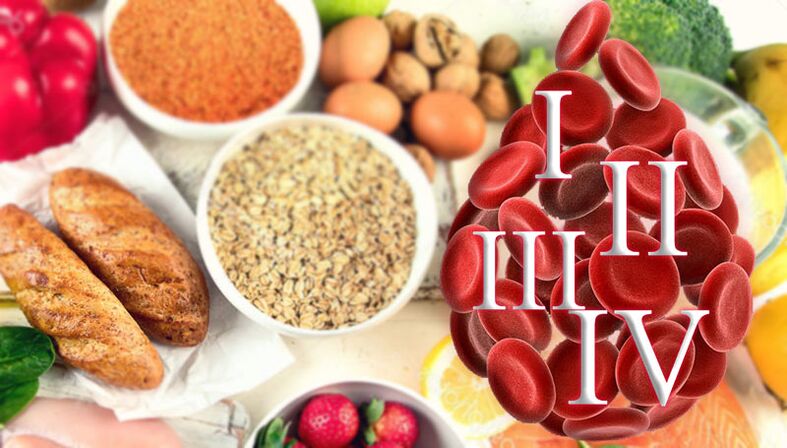The blood type nutrition method was developed by American doctor Peter D'Adamo. According to his theory, the body's ability to digest food and efficiently use it is directly related to a person's genetic characteristics. Specifically with your blood type. For the normal functioning of the immune and digestive systems, a person needs to eat foods that correspond to his blood type, or in other words, the foods that his ancestors ate in ancient times. The removal of blood-incompatible substances from the diet reduces adhesions in the body, improves the functioning of internal organs and promotes weight loss. The consumption of the same "foreign" product leads to a sagging body and a rapid increase in body fat.

Blood group nutrition theory causes heated debates among physicians, which has not yet subsided. On the basis of D'Adamo's techniques, different blood type diets have been developed, which have recently become very fashionable. According to D'Adamo, what should people with different blood types eat?
Food according to first blood group
People with 1 blood type (0) and so-called "hunters" should rely on animal protein, and they should refuse bread, pasta and dairy products.
Blood type 1 (0) is the oldest and most common. People with the first blood type are meat eaters with persistent digestive tracts, overactive immune systems and poor adaptation to new diets. The digestive system of the "hunter" has not yet adapted to dairy products and cereals.
Exceptionally useful product
Lean meats (lamb, beef), salmon, cod, pike, olive oil, walnuts, pumpkin seeds, beets, figs.
Food should be limited
Dairy products, cheeses, cheeses, fatty meats, especially pork, pasta and other flour products, potatoes, strawberries, tangerines, oranges, melons, avocados, corn and peanut butter, olive.
Weight gain food
Wheat, corn, beans, beans, cabbage, cauliflower.
Weight loss food
Red meat, liver, seafood.
Nutrition according to the second blood group
Representatives of the 2nd blood group (A) - "farmers" - are encouraged to be vegetarian.
The appearance of blood type 2 (A) is associated with the transition of humans to agriculture. Owners of the second blood group are vegetarians with sensitive digestive tracts. They need eco-friendly natural food. People with the second blood type need to exclude meat from the diet: if in the body of the "hunter" meat is burned as fuel, then in the "farmer" it turns into fat. They are also poorly absorbed in dairy foods. But the "farmer" can eat a wide variety of natural products with low fat content, vegetables and grains.
Exceptionally useful product
Moderate seafood, soybeans, beans, beans, buckwheat, rice, artichokes, Jerusalem artichokes, vegetable oils, soy products, vegetables and pineapple.
Food should be limited
Bread, potatoes, apricots, cranberries, ketchup, mayonnaise. Meat and meat products should be completely excluded from the diet.
Weight gain food
Meat, dairy products, beans, wheat.
Weight loss food
Vegetable oils, soybean products, vegetables, pineapple.
Nutrition according to the 3rd blood group
Blood type 3 (B) appeared when human tribes began to migrate north, in an area with a harsh climate. Therefore, people who possess the third blood type D'Adamo called "nomads". They have a strong immune system, and they can make food choices more freely than people with 1 and 2 blood types. The "nomads" are the main consumers of milk. The right combination of physical and mental activity will help them stay in shape and in a good mood.
Soybean, chicken, sunflower oil, tomato and pomegranate are contraindicated in people with third blood type; All dairy products, fish, lamb, rabbit and flaxseed oil are useful.
Exceptionally useful product
Lamb, rabbit, mackerel, cod, halibut, goat's milk cheese, olive oil, oatmeal, rice, parsley, cabbage, pineapple, plum.
Food should be limited
Goose meat, chicken, beef, pork, heart, shrimp, anchovies, lobster, eel, sunflower, peanut and corn oil, buckwheat, rye bread, tomato, pomegranate, persimmon.
Weight gain food
Corn, lentils, peanuts, buckwheat, sesame seeds.
Weight loss food
Red meat, liver, liver, low-fat dairy products, green vegetables, eggs.
Nutrition according to the 4th blood group
Blood type 4 (AB) appeared less than a thousand years ago due to the mixing of other groups. Hence the name: "new person". People with fourth blood type respond quickly to changes in the environment and nutrition. They have sensitive digestive tracts and overpowered immune systems. The best way to stay in shape is to combine mental work with light physical activity.
The basis of nutrition for owners of the fourth blood type should be fat-free food yogurt, lamb, venison, vegetables and fruits.
The amount of extra weight is affected by mixed heritability. To lose weight, people with 4 blood types need to limit eating meat, combined with vegetables. Ancestry B's inheritance is insulin-negative for beans, corn, buckwheat, and sesame seeds. But thanks to their ancestors, their bodies accepted lentils and peanuts well. Unlike both, people AB respond well to wheat.
Exceptionally useful product
Lamb, turkey, cod, mackerel, dairy products, corn oil, oatmeal, bread, broccoli, cranberries, pineapple.
Food should be limited
Beef, bacon, duck, halibut, crab, salmon, whole milk, olive oil, pumpkin seeds, beans, buckwheat, radish, avocado, banana, pomegranate.
Weight gain food
Red meat, beans, corn, buckwheat, wheat.
Weight loss food
Seafood (except canned, dried, dried and smoked), soybeans, dairy products, green vegetables, pineapple.
A small conclusion
The above are specific foods for the nutrition of each blood type. However, each of us has unique characteristics. So, when choosing food, choosing a diet by blood type, one must take into account not only general recommendations, but first of all the individuality of each person, first of all - the origin and blood type ofancestor.
Doctors have yet to agree on how effective the blood type diet is, although most nutritionists consider this theory at least valid. For people with any chronic diseases, blood type nutrition should be used very carefully, remember to consult a doctor.






























